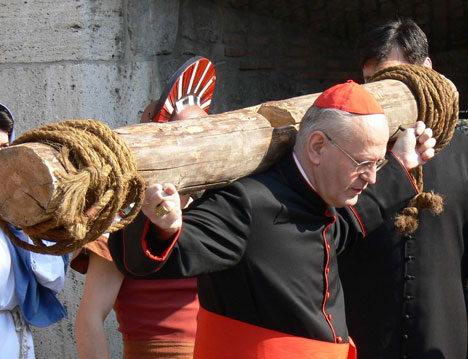Massive scale of sexual abuse at oldest abbey in Europe
Saint-Maurice Abbey: Investigation documents 67 "situations of sexual violence"
An independent working group commissioned by Saint-Maurice Abbey investigated cases of sexual abuse and examined the monastery's handling of them. Their report documented 67 "situations of sexual violence" in the broader sense. Thirty adult perpetrators were identified, mostly canons. At least 68 of the victims were mostly minors.
The working group's investigation report has a media history: In November 2023, the French-speaking Swiss television station RTS broadcast two reports on allegations of abuse against canons of Saint-Maurice Abbey in Valais in its program "Mise au point."
Interdisciplinary Working Group
Subsequently, the abbey commissioned Pierre Aubert, Attorney General of the Canton of Neuchâtel, to form an independent working group to investigate alleged cases of sexual abuse in the monastery's environment. This group includes three historians, Anne-Françoise Praz, Professor of Contemporary History at the University of Fribourg (Switzerland), Stéphanie Roulin, and Magali Delaloye; social scientist Lorraine Odier; lawyer Pierre Aubert; and retired judge Claire-Lise Mayor Aubert.
After a year of research, the working group published its investigative report on Friday. According to a press release, the investigation was less about an in-depth examination of individual cases. Rather, the aim was to "determine which situations of violence or sexual abuse were revealed by witness statements and archival material, in what context this violence was perpetrated, how the institution dealt with it, what consequences it had for the perpetrators, how the victims were heard, and whether any changes in these factors were observed over time."
The investigation covered the abbey and the boarding school, but not the college, i.e., the school, of the canons.
Archival research and oral sources
The archives of the Abbey of Saint-Maurice were available as sources for the period from 1950 to 2024, "without restriction," as stated in the report, written in French. The working group also collected 57 witness statements and heard from 24 clergy, including 23 canons.
The researchers found that there were indeed "situations of sexual violence" in the abbey's environment between 1960 and 2024. They clarified that the term "sexual violence" is based on the perceptions of those affected. It is not the "nature of the act" that defines violence, but rather the fact that an act is imposed on someone.
30 perpetrators and 68 victims
They found 67 "situations of violence" attributed to 30 adult men who either belonged to the monastic community or lived there. At least 68 people were affected by the assaults, and 57 victims were minors at the time of the crime.
This list does not allow "any conclusions about the reality of sexual violence in the abbey environment," the authors emphasize. It is "highly likely" that many situations escaped their attention, either because the sources, the perpetrators, or the victims remained silent. It is also uncertain whether the events occurred as reported.
The incidents occurred between 1960 and 2024, both inside and outside the abbey, in Switzerland and abroad.
Sexual harassment, rape and abortion
The researchers also attempted to determine which forms of sexual violence were perpetrated. Among other things, they found: gestures and words with sexual undertones in a relationship of authority, sexualized staging for photo shoots, exhibitionism, seduction in a relationship of authority, repeated sexual touching, spiritual abuse, rape, consumption of child pornography, multiple involuntary abortions, fellatio, sexual harassment.
Five penal orders and one pending case
According to the researchers, the secular judiciary has issued five penal orders against three canons and one novice since 1970. A large number of cases have been dropped, either due to a lack of sufficient charges or due to the statute of limitations, the statement states. One court case is still pending, however, this case does not involve a canon, but rather a layperson with ties to the abbey.
Monastery's failure in dealing with abuse
The working group gives the monastery a poor report card in its handling of reports of abuse. It accuses the monastery of adopting a "defensive attitude" that primarily aims to protect the abbey's reputation. "Suspected or denounced canons are transferred, and those in charge of the abbey try to cover up the actions of their accused colleagues and downplay them by using vague or euphemistic language," the authors write in the investigation report.
If the silence is broken by the press or a police operation, "they produce a reassuring discourse, downplay the acts, or offer an individual psychopathological explanation that exonerates the institution." In the area of prevention, however, they observed a "greater awareness of the problem," particularly through more careful selection of novices.
No sensitivity to the victims' needs
Since the working group was mandated, the abbey's management has reported all matters of which it was aware that could be relevant to criminal law to the ordinary courts, even when they were demonstrably statute-barred, the communiqué states. At the same time, however, members of the community with ambivalent or even unlawful behavior were allowed to remain in office without special precautions, the working group criticizes.
The group was also able to determine why the monastery failed in its dealings with the victims. "If the act is not criminally reprehensible or not defined as a sin according to Catholic doctrine, it is not considered serious in the eyes of those responsible at the abbey," the report states. Thus, the victims' experiences are not taken into account. This attitude leads to a distance from the victims and their families and makes it impossible to understand their needs.
Internal monastery problems
The working group sees a connection between this failure and the state of the monastic community, citing it as a "systemic factor." They observed "inadequate community life" and poor internal communication. This deficit reduces the opportunities to address the difficulties of fellow monks, issue warnings, and share concerns, according to the report. The communication difficulties are also evident in dealing with abuse.










.jpeg)

Comments